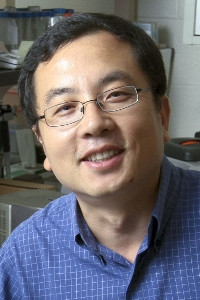Taste loss, taste renewal, and beyond

Dr. Peihua Jiang
March 8 at 12:20pm in the Fralin Auditorium, Fralin Hall room 102
Hosted by Dr. D. Good
Dr. Jiang received his Bachelor’s Degree in Biology from Nankai University in Tianjin, China, his Master’s Degree in Biophysics from the Institute of Biophysics of Chinese Academy of Sciences, and his Ph.D. in Neurobiology from the University of Pittsburgh, where he discovered that CD47 is the receptor for SIRPα. He then went on to receive his post-doctoral training at the University of Pittsburgh, where he studied the role of oxidative stress in the selective vulnerability of dopaminergic neurons in Parkinson’s disease under the supervision of Dr. Teresa Hastings, and at the Mount Sinai School of Medicine, where he studied the structural and functional relationships of taste receptors under the supervision of Dr. Robert Margolskee. Dr. Jiang joined Redpoint Bio as a senior scientist in 2007 and moved to the Monell Chemical Senses Center in 2009. Promoted to Assistant Member in 2012, he currently an Associate Member of the Monell Center. His laboratory uses a combined molecular biology, cell biology, animal physiology approach to aim to provide a better understanding of how taste receptors evolved, how taste stem cells maintain taste tissue homeostasis, and how intestinal “taste-like” tuft cells sense pathogens.
In this talk, I will discuss three topics. The first addresses the relationship between taste receptor function and an animal’s feeding ecology, based on the discovery that several obligate carnivore species have independently acquired a defective Tas1r2 allele and thus lack sweet taste. This sensory deficit is consistent with these species’ meat-eating behavior and suggests convergent evolution. The second topic involves characterizing the biology of adult taste stem cells. It is based on the discovery that Lgr5 marks adult taste stem cells, and that single Lgr5-expressing stem cells can generate all three types of mature taste receptor cells in culture (“taste organoids”). The third topic involves understanding how intestinal tuft cells (“taste-like cells” in the gut) sense pathogens. My laboratory found that type 2 immunity is triggered by activation of the succinate receptor Sucnr1, which is selectively expressed in tuft cells. This defense mechanism is used in some, but not all, host-pathogen interactions. My laboratory continues to focus on these three areas of research to better understand how taste receptors evolved, how taste stem cells maintain taste tissue homeostasis, and how intestinal tuft cells recognize pathogens.
Major taste loss in carnivorous mammals. http://www.pnas.org/content/early/2012/03/06/1118360109.short
Lgr5‐EGFP marks taste bud stem/progenitor cells in posterior tongue. https://stemcellsjournals.onlinelibrary.wiley.com/doi/full/10.1002/stem.1338
Single Lgr5- or Lgr6-expressing taste stem/progenitor cells generate taste bud cells ex vivo. http://www.pnas.org/content/111/46/16401.short
Activation of intestinal tuft cell-expressed Sucnr1 triggers type 2 immunity in the mouse small intestine. http://www.pnas.org/content/115/21/5552.short

This seminar will be livestreamed on the Fralin YouTube channel, but will not be recorded.


